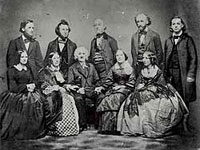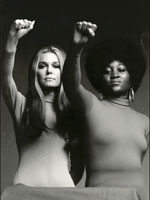Milliner and Mantua Maker
Janea Whitacre, Colonial Williamsburg's mistress of the millinery and mantua-making trades, examines the business of female fashion in the colonial era.
Janea Whitacre, Colonial Williamsburg's mistress of the millinery and mantua-making trades, examines the business of female fashion in the colonial era.
In this lecture, historian Mary Beth Norton examines the original court documents from the Salem witchcraft trials; she places these well-known events in the context of the Indian wars and other witch trials in New England. The trials, she concludes, were driven more by politics than by superstition.
Harriet Tubman was born into slavery in Maryland in 1820. After her escape to the North in 1849, she returned to the South more than a dozen times to ferry other slaves along the Underground Railroad. She later helped John Brown recruit men for his Harper's Ferry raid; and during the Civil War, Tubman served as a Union spy. In this lecture, historian Catherine Clinton details not only Tubman's life but also the quest to uncover new information on Tubman.

This combined archive and exhibit offers a selection of 448 photographs from the Library's National Woman's Party (NWP) collection that "document the National Woman's Party's push for ratification of the 19th Amendment as well as its later campaign for passage of the Equal Rights Amendment." Photographs span the years 1875 to 1938, but most date from 1913 to 1922. Visitors can browse photographs by title or subject or search the descriptive information. The site has a photo gallery of more than 50 photographs depicting NWP activists who were arrested and imprisoned for their role in suffrage protests. Additionally, the site provides a timeline of the National Woman's Party from 1912 to 1997 that places it in historical context. The site also provides three essays: on the tactics and techniques of the National Woman's Party suffrage campaign, a historical overview of the NWP, and on leaders of the NWP.
From the Library of Congress Webcasts site:
"On May 1, 1893, the World's Columbian Exposition in Chicago opened its gates to an expectant public eager to experience firsthand its architectural beauty, technological marvels and vast array of cultural treasures gathered from all over the world. Among the most popular of the fair's attractions was the Woman's Building, a monumental exhibit hall filled with the products of women's labor, including more than 8,000 volumes of writing, by women and collected by women—the first important library of its kind. Hundreds of thousands of women visited the library and took what they learned to develop local libraries."

This exhibit, based on an exhibit at the William and Anita Newman Library of the City University of New York, explores the history of the Beechers, a New England family influential in religious, abolitionist, and women's rights movements. The site provides 500-word biographies, photographs, and excerpts from letters for seven members of the Beecher family, beginning with patriarch Lyman Beecher, Presbyterian minister and President of Lane Theological Seminary in Cincinnati. It also profiles Lyman's two wives; five of his children, including Harriet Beecher Stowe, author of Uncle Tom's Cabin and more than 30 other works; and his great-granddaughter Charlotte Perkins Gilman, women's rights activist and author of Women and Economics. The site also offers links to six related websites and a bibliography of six related scholarly works. It is a good resource for those researching abolitionism, women's rights, or the lives of the Beechers.

Selected materials from the personal papers of Mary Metlay Kaufman, Dorothy Kenyon, Constance Baker Motley, Jessie Lloyd O'Connor, Frances Fox Piven, and Gloria Steinem. Also includes papers of the National Congress of Neighborhood Women (NCNW) and the Women's Action Alliance (WAA). The six women and two organizations are introduced with biographical essays (300-700 words). For each woman, the site provides from three to six texts, of 100 to 1,000 words, including correspondence, photographs, articles written by or about them, and bulletins and newsletters for movements with which they worked. Material includes fan mail received by Steinem, a letter from William Z. Foster to Kaufman, and a five-page speech Motley made to the Children's Organization for Civil Rights.
Papers for the NCNW include two photos, one poster, a brochure, and six pages of projects and activities. The WAA exhibit presents one photo, a press release, a mission statement, and a brochure. There are six high school lesson plans using the primary documents. The site will be useful for research in 20th-century feminism and women's activism.
With Teachinghistory.org's women's history resources and the rich resources available elsewhere on the Web, you can find ideas and materials for any time period, topic, or grade level. Whether you're covering well-known events like the Seneca Falls Convention or helping your students uncover little-known figures from history, primary sources, digital tools, and thoughtful teaching strategies can bring women's history to life in March—and in every month of the year!

Start your search for resources on our Women's History Month spotlight page, where you'll find website reviews, lesson plans, quizzes, videos, and other materials that encourage historical thinking.
Need even more resources? Try these suggestions for exploring Women's History Month materials beyond Teachinghistory.org:
Remember not to limit teaching about women in U.S. history to March! Many of these resources, as well as our spotlight page, are available year-round.
From the Colonial Williamsburg: Past and Present Podcasts website—
"The manners of the parlor codify the feminine culture. Kristen Spivey keeps up appearances in The Polite Academy."
For a full transcript of this podcast, click here.
Interested listeners can also click here to read an excerpt from a book on Colonial manners.
From Colonial Williamsburg: Past and Present Podcasts
"Could the Revolution have been won without women? Author and Professor Holly Mayer thinks not. Learn more about the inner workings of the Continental Army."
The Colonial Williamsburg site also has an informative essay that offers interested readers more information on the roles women played during the Revolutionary War.